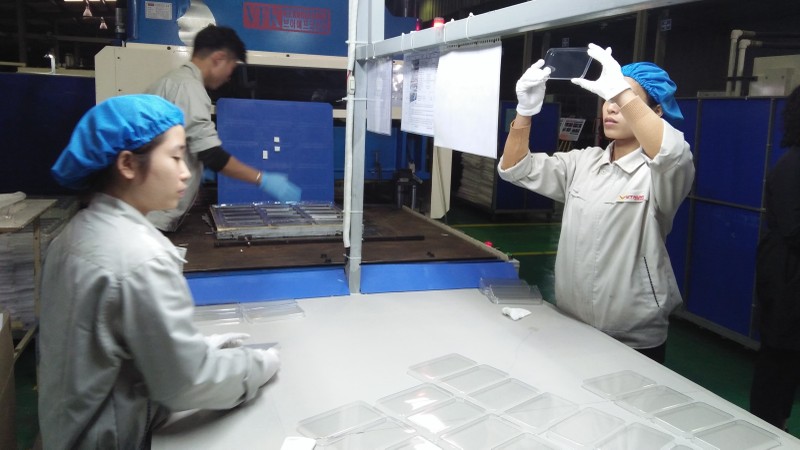Over the past few months, all six factories of locally-owned Phuc Sinh Corporation, which produces and exports agricultural items, have been operating at full speed with two shifts a day instead of the usual one shift.
“Amid the difficulties caused by COVID-19, we must double down on our efforts and try to reach a 70% rise in revenue this year and even next year,” the corporation’s chairman and general director Phan Minh Thong told Nhan Dan Online.
Currently the firm is exporting to big markets including Europe, North America, and the Middle East.
“Though these markets are hurting due to the pandemic, their demand for consumption remains strong as many economies in these regions are regaining growth momentum, creating opportunities for firms like us to boost exports,” Thong said.
According to some high-profile international organisations, in Vietnam, many businesses like Phuc Sinh are still performing well, contributing to the country’s growth, which is expected to climb by 6.5-7% next year – the highest rate in Southeast Asia – after hitting an estimated rate of below 5% this year due to negative impacts of the global health emergency.
“The Vietnamese government is implementing huge packages to support local production and exports. If these measures are well deployed, they will help the economy bounce back quickly in the second half of 2020 and into 2021,” said an Asia Development Bank (ADB) economic expert.
The ADB has forecast that Vietnam’s economic growth will drop sharply in 2020 to 4.8%, but if the outbreak is contained within the first half of 2020, the rate will rebound to 6.8% next year and should remain strong over the medium and long term.
“Despite the potentially large impact of COVID-19, Vietnam’s economic fundamentals remain resilient. The drivers of economic growth – a growing middle-income class, a dynamic private sector, and particularly household businesses and domestically-held enterprises – remain robust,” the expert said.
The World Bank is also seeing a bright outlook for Vietnam after the crisis is controlled. It stated that over the medium term, growth is projected to rebound back to 7.5% in 2021 and converge at around 6.5% in 2022, “reflecting improved external demand and strengthening of the services sector, as well as a gradual recovery in agricultural production, the economy will also rebound from the coronavirus pandemic.”
Meanwhile, the International Monetary Fund has also forecast that Vietnam will achieve the fastest growth in ASEAN this year, at 2.7% , before bouncing back to 7% in 2021.
Last week, global business information analyst and provider TradingEconomics projected that Vietnam’s GDP will grow by 6.5% both this year and next year.
“GDP in Vietnam is expected to reach US$265 billion by the end of 2020, according to Trading Economics global macro-models and analyst expectations. In the long-term, the Vietnam GDP is projected to trend around US$289 billion in 2021 and US$325 billion in 2022,” TradingEconomics said in a statement.
Standard Chartered Bank also expects Vietnam’s economy to grow 3.3% in 2020 due to increased external headwinds.
“Vietnam is now more integrated with the global economy via its booming manufacturing sector; its trade-to-GDP ratio has risen to 300%, among the highest in Asia, signifying its high dependence on global demand,” said Chidu Narayanan, economist for Asia of Standard Chartered Bank. “Lower global demand amid likely recessions in the US, the Euro area and other G10 economies will weigh on growth in 2020. We see growth rebounding to 6.5% in 2021 given an expected demand recovery and the low base from 2020.”
According to the ADB, one of the key drivers for Vietnam to grow strongly next year is that the country has one of the fastest-growing middle classes in Southeast Asia. According to Boston Consulting Group, that grouping has doubled in size since 2014 to 33 million, or a third of the population.
“The business environment similarly continues to improve. The disbursement of public investment has improved significantly, growing by nearly 18% in January and February over the same period in 2019,” stated a fresh ADB report on Vietnam. “Disbursement will continue to improve in 2020 as this is a priority fiscal measure in response to COVID-19.”
Moreover, the large number of bilateral and multilateral trade agreements in which Vietnam participates promise the improved market access essential for economic rebound after the pandemic. Containment of the coronavirus in China, and that its market is likely return to normal, will help revive global value chains and facilitate economic recovery in Vietnam, the report stated.
According to Thong of Phuc Sinh, such agreements will enable the corporation and many other companies in Vietnam to further boost their exports.
“For example, we are exploring new markets in the EU – if the EU-Vietnam Free Trade Agreement takes effect this year, we will surely earn more profits as we have already secured a foothold in Europe,” Thong said. “The domestic business climate is also improving remarkably, facilitating enterprises to perform better and contributing more to national economic growth.”
















